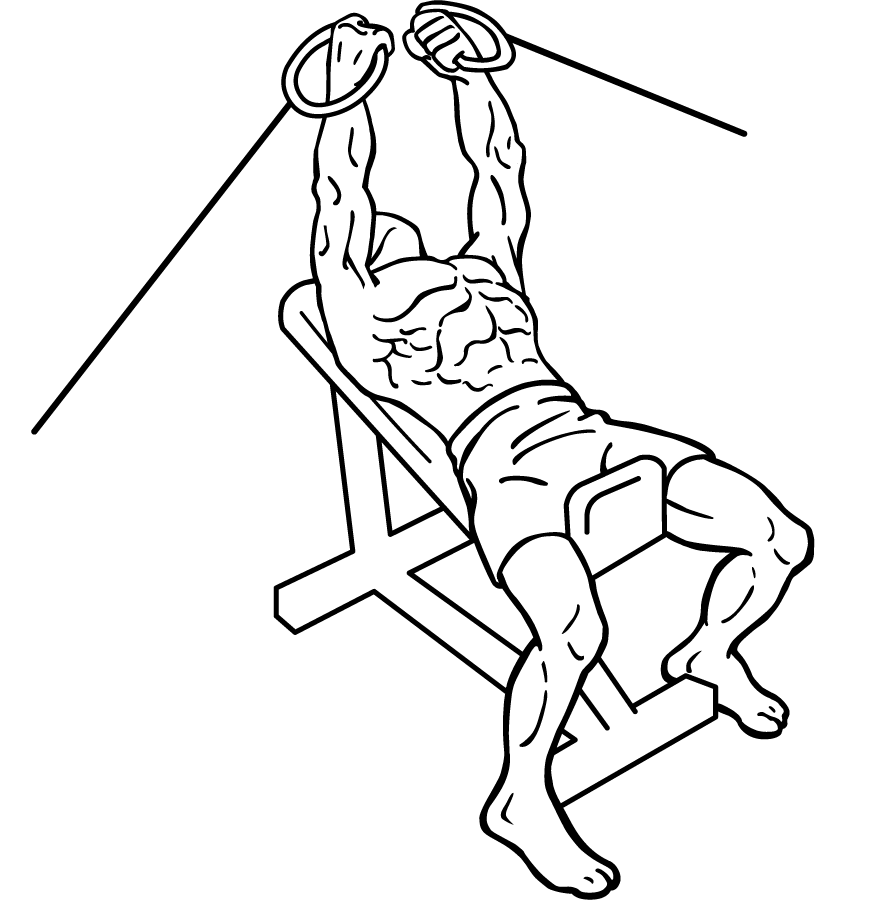Last Updated on September 30, 2022
The incline cable flyes is a powerful exercise that targets the upper chest muscles, providing an excellent alternative to traditional exercises like the butterfly or pec deck. Using cables allows for a continuous, even resistance throughout the movement, leading to improved muscle activation and growth. This blog will dive into the benefits of incline cable flyes, provide a step-by-step guide for proper execution, and offer variations, tips, and safety considerations to maximize your workout.
Why Incline Cable Flyes?
Incline cable flyes are an effective exercise for several reasons:
- Targeted Muscle Activation: The incline position focuses on the upper portion of the pectoral muscles (pectoralis major), helping to create a fuller, more sculpted chest.
- Full Range of Motion: Unlike dumbbells, which rely on gravity, cables provide constant tension throughout the entire movement, allowing you to work your chest muscles from full stretch to peak contraction.
- Muscle Isolation: This exercise isolates the chest muscles more effectively than other compound movements like the bench press, reducing the involvement of secondary muscles like the triceps and shoulders.
- Versatility and Control: Cables offer a smoother motion, making it easier to control the movement and adjust the resistance based on your fitness level.
By integrating incline cable flyes into your routine, you can sculpt a defined and strong upper chest, improving both the aesthetics and functional strength of your upper body.
How to Perform Incline Cable Flyes Properly
Performing this exercise with proper technique is crucial for achieving the best results and avoiding injury. Follow these steps carefully:
- Setting Up the Equipment
- Begin by positioning an incline bench at a 45-degree angle between two cable towers. Ensure the bench is stable and the cables are set at a height that aligns with your shoulders when you’re seated.
- Choose a weight that allows you to perform the exercise with control and full range of motion. Start light if you’re new to this exercise to focus on perfecting your form.
- Grabbing the Cables
- Stand in between the cable towers and grasp a pulley handle in each hand. Your palms should face upward (supinated grip) as you pull the cables across your body.
- Sit back on the incline bench, resting your feet flat on the floor to stabilize yourself. Lean your upper back against the bench, ensuring your spine remains neutral and your head is in line with your back.
- Positioning Your Arms
- Extend your arms outward so that they are in line with your chest, with a slight bend in your elbows. Your arms should form an arc-like shape, ensuring there’s a slight stretch across your chest muscles at the starting position.
- Keep your shoulders retracted and down to minimize shoulder involvement and focus the tension on your chest.
- Executing the Movement
- Exhale as you squeeze your chest muscles and bring your arms together in a controlled arc motion. The cables should meet in the middle of your chest. At the top of the movement, your hands should almost touch, and your chest should be fully contracted.
- Pause briefly at the top of the movement, holding the contraction for a moment to maximize muscle engagement.
- Returning to the Starting Position
- Inhale as you slowly lower your hands back to the starting position along the same arc. Keep the movement controlled to prevent the cables from pulling your arms back too quickly. The aim is to feel the stretch across your chest as you return to the starting position.
- Repeat for the desired number of repetitions, typically 10-12 for muscle growth and definition.
Tips for Mastering the Incline Cable Flyes
To maximize the benefits of this exercise, consider these tips:
- Maintain a Slight Bend in the Elbows: This helps reduce strain on the elbow joints and keeps the focus on the chest muscles throughout the movement.
- Focus on the Contraction: When bringing the cables together, visualize your chest muscles contracting and squeezing. This mind-muscle connection enhances muscle activation and growth.
- Control the Eccentric Phase: The lowering phase (eccentric) of the exercise is where most muscle damage and growth occur. Slowing down during this phase increases muscle tension, leading to better results.
- Engage Your Core: Stabilize your core and keep your back pressed against the bench to prevent any arching or unnecessary movement.
Common Mistakes to Avoid
- Using Too Much Weight
- It’s tempting to go heavy, but using too much weight can compromise form and lead to shoulder strain. Start light, and only increase the weight once you can maintain proper form throughout the set.
- Letting the Elbows Drop Too Low
- If your elbows drop too low during the movement, you risk shifting the tension away from the chest and placing it on your shoulders. Keep your elbows in line with your chest to target the pectoral muscles effectively.
- Arching the Lower Back
- Keep your lower back pressed against the bench throughout the exercise. Arching your back can reduce the effectiveness of the movement and increase the risk of injury.
- Rushing the Movement
- Incline cable flyes are about control, not speed. Focus on slow, deliberate movements to fully engage your chest muscles and reduce momentum.
Benefits of Incline Cable Flyes
This exercise offers a range of benefits that can elevate your chest workouts:
- Upper Chest Development: The incline position places emphasis on the upper chest muscles, helping create a well-rounded and sculpted chest appearance.
- Improved Range of Motion: Cables provide a wider range of motion than dumbbells, allowing for a deeper stretch and fuller contraction.
- Enhanced Muscle Activation: The constant tension from cables ensures that your muscles are activated throughout the entire range of motion, leading to more effective muscle growth.
- Low Impact on Joints: The smooth motion of the cables reduces joint strain, making it a suitable option for people with shoulder or elbow issues.
Variations to Challenge Your Chest
Once you’ve mastered the traditional incline cable fly, you can try these variations to keep your chest workouts dynamic and challenging:
- Single-Arm Incline Cable Fly
- Perform the fly one arm at a time. This variation increases core engagement as your body works to stabilize itself while you isolate each side of your chest individually.
- Incline Cable Fly with a Twist
- As you bring the cables together, twist your wrists so that your palms face downward. This variation targets the inner chest muscles more effectively and adds a new challenge.
- Reverse Incline Cable Fly
- Turn the bench around so that you face the cables. This version targets the rear deltoids and upper back muscles, providing a balanced chest and upper-body workout.
- Incline Cable Fly Superset with Push-Ups
- Combine the incline cable fly with push-ups in a superset for a high-intensity chest workout. This approach fatigues the muscles completely, promoting greater muscle growth and endurance.
- Decline Cable Fly
- Adjust the bench to a decline position (lower than flat) to shift the focus onto the lower chest muscles. This variation works the entire chest, providing a balanced development.
Safety Tips and Considerations
While incline cable flyes are generally safe when performed correctly, keep these considerations in mind to minimize the risk of injury:
- Warm Up Properly: Warm up your chest, shoulders, and arms before performing cable flyes. Light cardio and dynamic stretches can prepare your muscles and joints, reducing the risk of strain.
- Use a Manageable Weight: Choose a weight that allows you to perform the exercise with full control. If you find yourself struggling to maintain form, reduce the weight to focus on technique.
- Ensure the Bench is Stable: Check that the incline bench is securely positioned between the cable towers. An unstable bench can cause imbalance and improper form.
- Avoid Overstretching: While it’s essential to feel a stretch in your chest muscles, avoid extending your arms too far back. Overstretching can lead to shoulder injury. Maintain a controlled range of motion to protect your joints.
Incorporating Incline Cable Flyes into Your Workout Routine
Here are some ways to integrate incline cable flyes into your upper-body or chest-focused workouts:
- Hypertrophy Routine: Aim for 3-4 sets of 10-12 reps with moderate weight. Focus on the eccentric phase and increase time under tension for maximum muscle growth.
- Strength Routine: Use heavier weight and perform 3-4 sets of 6-8 reps. Keep the movements controlled and slow, emphasizing the contraction at the top of the fly.
- Chest-Focused Superset: Pair incline cable flyes with other chest exercises like bench press or push-ups to target the pectoral muscles from different angles and increase volume.
- Circuit Training: Include incline cable flyes as part of a circuit that combines upper-body exercises like cable rows, shoulder presses, and lateral raises for a full upper-body workout.
Incline cable flyes are a powerful exercise for developing the upper chest, enhancing muscle definition, and building functional strength. Whether you’re a beginner or an advanced lifter, incorporating this movement into your routine offers variety and effective results. Focus on proper form, start with manageable weights, and explore variations to continually challenge your muscles and achieve your fitness goals.
By taking the time to master this exercise and its variations, you’ll build a stronger, more defined chest, giving you the confidence and strength to excel in both aesthetics and performance. Remember, consistency is key—keep practicing, adjust weights gradually, and monitor your progress to see continual improvements in your chest development.
Final Thoughts
Incline cable flyes are more than just a chest exercise; they are a dynamic tool to shape and sculpt your upper body. By using cables, you not only work on the upper portion of your chest but also enhance muscle stability and control through a wider range of motion than free weights alone can provide.
Whether your goal is to achieve a more defined chest, increase strength, or improve muscular endurance, incline cable flyes can be adapted to suit your needs. Start with the basic movement, then gradually explore variations and adjustments to continually push your limits. Tracking your progress, maintaining proper form, and challenging your muscles with different intensities and volumes will help you build a balanced and powerful chest.
Remember, the quality of your reps is more important than the quantity or the weight you lift. Take your time with each repetition, focus on the mind-muscle connection, and prioritize form to get the most out of your workouts.
So, next time you head to the gym, make the incline cable flyes a part of your chest day routine. You’ll not only feel the difference in your workout but will also see the impact in your chest’s strength and definition over time. Keep lifting, stay consistent, and enjoy the gains!







